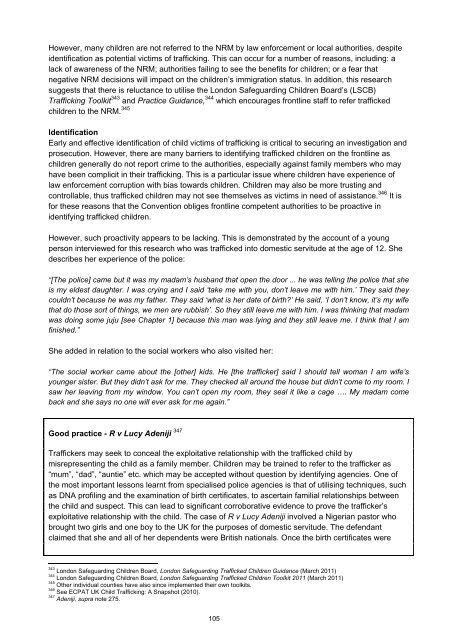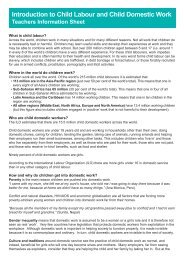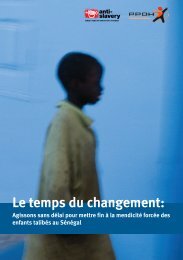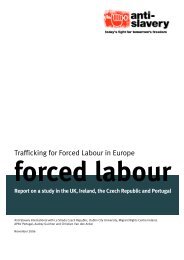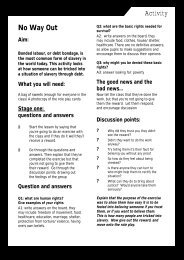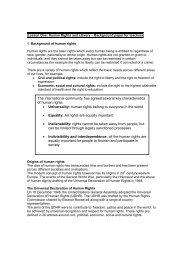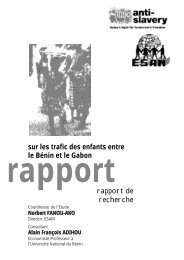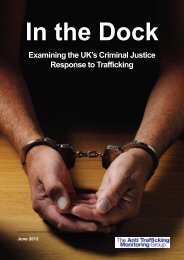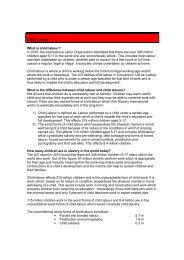application of <strong>the</strong> UK’s anti-trafficking legislation and <strong>the</strong> Convention. For instance <strong>the</strong> “act” element isrooted in child sexual offences in <strong>the</strong> SOA but not all of <strong>the</strong>se offences interpret a child as personsbelow <strong>the</strong> age of 18.<strong>In</strong> 2012, <strong>the</strong> Council of Europe Group of Experts on Action against Trafficking in Human Beings(GRETA) noted this irregularity among o<strong>the</strong>rs: “<strong>In</strong> England, Wales and Nor<strong>the</strong>rn Ireland, children arepersons under <strong>the</strong> age of 18, however, pursuant to Sections 5 to 14 of <strong>the</strong> Sexual Offences Act (SOA)2003 … trafficking for <strong>the</strong> purpose of sexual exploitation includes offences against children defined aspersons under 13 years of age or under 16, but mistaken by <strong>the</strong> offender to be older. GRETA alsonotes that Section 4(4)(d) of <strong>the</strong> Asylum and Immigration (Treatment of Claimants, etc.) Act 2004refers to “young” persons without clearly designating children for <strong>the</strong> purposes of <strong>the</strong> Convention (i.e.persons under <strong>the</strong> age of 18).” 340 This lack of clarity around <strong>the</strong> age of a child in UK law, as well as <strong>the</strong>use of <strong>the</strong> undefined word “young” in <strong>the</strong> AI(TC)A can cause confusion for those who are unfamiliarwith <strong>the</strong> legalisation and are attempting to utilise it in child trafficking cases. It is for <strong>the</strong>se reasons,coupled with o<strong>the</strong>r difficulties outlined in Chapter 2, that practitioners have looked to prosecute underrelated offences such as child cruelty or unlawful facilitation.Statistics on child traffickingThere was a general consensus among interviewees that child trafficking has a lower profile, is not asvisible and as well documented as adult trafficking, which may partially account for <strong>the</strong> lower numberof prosecutions. One law enforcement officer stated:“The profile of trafficking of children isn’t as high as <strong>the</strong> trafficking of adults ... People don’t like to thinkthat children are trafficked. So, it’s almost like wilful blindness, <strong>the</strong>y don’t want to think that ithappens.”Child trafficking statistics are a key indicator to assess <strong>the</strong> effectiveness of <strong>the</strong> UK’s CJS response tochild trafficking. Accurate and reliable data on how many children are trafficked into, within and out of<strong>the</strong> UK, is needed in order to debunk <strong>the</strong> myth that child trafficking is uncommon. Between April 2009and June 2012, 784 children were referred to <strong>the</strong> NRM as potential victims of trafficking. However, arecent UKHTC report identified 489 child victims in 2011 alone when it collated data from a variety ofsources, including <strong>the</strong> NRM and o<strong>the</strong>r stakeholders (this figure only represents those who receivedpositive Reasonable or Conclusive Grounds decisions). 341This number is likely to be much higher in reality as <strong>the</strong> UKHTC study did not collate data from localauthority children’s services. Despite <strong>the</strong>se high numbers, <strong>the</strong>re have been a total of 49 convictions(for both adults and children) under all trafficking legislation since 2009. Unfortunately, <strong>the</strong> data forconvictions is not disaggregated into adults and minors. Therefore, it is unknown how manyprosecutions were for child trafficking and it is <strong>the</strong>refore difficult to analyse whe<strong>the</strong>r <strong>the</strong> UK’s criminaljustice response to trafficked children differs significantly from adults. It was, however, agreed by <strong>the</strong>majority of interviewed stakeholders that few offenders are being brought to justice for traffickingoffences against children, which may send out a message that child trafficking is a low-risk, high-profitcrime.Once a child has been identified as a suspected victim of trafficking, government guidance promotesreferral to <strong>the</strong> NRM as required by Article 10 of <strong>the</strong> Convention. 342 Referring a child into <strong>the</strong> NRM mayhave a positive impact as it encourages <strong>the</strong> sharing of information between agencies and can help toensure an appropriate safeguarding response. NRM statistics can also identify patterns in childtrafficking that can aid law enforcement investigations and lead to better evidence ga<strong>the</strong>ring.340GRETA, supra note 87, p.25.341SOCA, supra note 19.342Association of Chief Police Officers, supra note 330.104
However, many children are not referred to <strong>the</strong> NRM by law enforcement or local authorities, despiteidentification as potential victims of trafficking. This can occur for a number of reasons, including: alack of awareness of <strong>the</strong> NRM; authorities failing to see <strong>the</strong> benefits for children; or a fear thatnegative NRM decisions will impact on <strong>the</strong> children’s immigration status. <strong>In</strong> addition, this researchsuggests that <strong>the</strong>re is reluctance to utilise <strong>the</strong> London Safeguarding Children Board’s (LSCB)Trafficking Toolkit 343 and Practice Guidance, 344 which encourages frontline staff to refer traffickedchildren to <strong>the</strong> NRM. 345IdentificationEarly and effective identification of child victims of trafficking is critical to securing an investigation andprosecution. However, <strong>the</strong>re are many barriers to identifying trafficked children on <strong>the</strong> frontline aschildren generally do not report crime to <strong>the</strong> authorities, especially against family members who mayhave been complicit in <strong>the</strong>ir trafficking. This is a particular issue where children have experience oflaw enforcement corruption with bias towards children. Children may also be more trusting andcontrollable, thus trafficked children may not see <strong>the</strong>mselves as victims in need of assistance. 346 It isfor <strong>the</strong>se reasons that <strong>the</strong> Convention obliges frontline competent authorities to be proactive inidentifying trafficked children.However, such proactivity appears to be lacking. This is demonstrated by <strong>the</strong> account of a youngperson interviewed for this research who was trafficked into domestic servitude at <strong>the</strong> age of 12. Shedescribes her experience of <strong>the</strong> police:“[The police] came but it was my madam’s husband that open <strong>the</strong> door ... he was telling <strong>the</strong> police that sheis my eldest daughter. I was crying and I said ‘take me with you, don’t leave me with him.’ They said <strong>the</strong>ycouldn’t because he was my fa<strong>the</strong>r. They said ‘what is her date of birth?’ He said, ‘I don’t know, it’s my wifethat do those sort of things, we men are rubbish’. So <strong>the</strong>y still leave me with him. I was thinking that madamwas doing some juju [see Chapter 1] because this man was lying and <strong>the</strong>y still leave me. I think that I amfinished.”She added in relation to <strong>the</strong> social workers who also visited her:“The social worker came about <strong>the</strong> [o<strong>the</strong>r] kids. He [<strong>the</strong> trafficker] said I should tell woman I am wife’syounger sister. But <strong>the</strong>y didn’t ask for me. They checked all around <strong>the</strong> house but didn’t come to my room. Isaw her leaving from my window. You can’t open my room, <strong>the</strong>y seal it like a cage …. My madam comeback and she says no one will ever ask for me again.”Good practice - R v Lucy Adeniji 347Traffickers may seek to conceal <strong>the</strong> exploitative relationship with <strong>the</strong> trafficked child bymisrepresenting <strong>the</strong> child as a family member. Children may be trained to refer to <strong>the</strong> trafficker as“mum”, “dad”, “auntie” etc. which may be accepted without question by identifying agencies. One of<strong>the</strong> most important lessons learnt from specialised police agencies is that of utilising techniques, suchas DNA profiling and <strong>the</strong> examination of birth certificates, to ascertain familial relationships between<strong>the</strong> child and suspect. This can lead to significant corroborative evidence to prove <strong>the</strong> trafficker’sexploitative relationship with <strong>the</strong> child. The case of R v Lucy Adeniji involved a Nigerian pastor whobrought two girls and one boy to <strong>the</strong> UK for <strong>the</strong> purposes of domestic servitude. The defendantclaimed that she and all of her dependents were British nationals. Once <strong>the</strong> birth certificates were343London Safeguarding Children Board, London Safeguarding Trafficked Children Guidance (March 2011)344London Safeguarding Children Board, London Safeguarding Trafficked Children Toolkit 2011 (March 2011)345O<strong>the</strong>r individual counties have also since implemented <strong>the</strong>ir own toolkits.346See ECPAT UK Child Trafficking: A Snapshot (2010).347Adeniji, supra note 275.105
- Page 1 and 2:
In the DockExamining the UK’s Cri
- Page 3 and 4:
AcknowledgementsThis report was mad
- Page 5 and 6:
PrefaceIn May 2009, a group of nine
- Page 7 and 8:
Misconceptions around exploitation
- Page 9 and 10:
Acronyms and abbreviations frequent
- Page 11 and 12:
Executive SummaryIn the Dock is The
- Page 13 and 14:
Furthermore, the current legislatio
- Page 15 and 16:
The ATMG was made aware of some cas
- Page 17 and 18:
• Introduce mandatory child-speci
- Page 19 and 20:
• The UK’s ability to meet the
- Page 21 and 22:
Traffickers’ primary motivation i
- Page 23 and 24:
• Money launderers - turn profits
- Page 25 and 26:
out to perpetuate the exploitative
- Page 27 and 28:
[their] own enslavement” is as fu
- Page 29 and 30:
Chapter 2: UK Anti-Trafficking Legi
- Page 31 and 32:
nationals who commit trafficking of
- Page 33 and 34:
Like the SOA, the “act” element
- Page 35 and 36:
(b) D requires another person to pe
- Page 37 and 38:
Forced or compulsory labourThe defi
- Page 39 and 40:
ConclusionAs a consequence of the s
- Page 41 and 42:
concerningly, the number of convict
- Page 43 and 44:
women who were recruited in Poland
- Page 45 and 46:
Chapter 4: Identifying trafficking
- Page 47 and 48:
Misconceptions around exploitationT
- Page 49 and 50:
espond inadequately to a trafficked
- Page 51 and 52:
multi-agency teams was described by
- Page 53 and 54:
Josie Connors. 179 In summary, inte
- Page 55 and 56: defending a trafficked person for f
- Page 57 and 58: “[B]ecause the NRM decision is on
- Page 59 and 60: PTSD. 196 A Consultant Psychiatrist
- Page 61 and 62: etween the client and the police, i
- Page 63 and 64: Regular communication needs to be s
- Page 65 and 66: Priority planningA particular issue
- Page 67 and 68: Chapter 6: Multi-agency and interna
- Page 69 and 70: canvassing for tarmacking opportuni
- Page 71 and 72: Despite this, it would appear that
- Page 73 and 74: Good practice - Operation Golf 229O
- Page 75 and 76: Chapter 7: Criminal proceedingsThe
- Page 77 and 78: Law enforcement working on the case
- Page 79 and 80: trafficking require particular unde
- Page 81 and 82: JuryPractitioners suggested that th
- Page 83 and 84: years”. 258 Ambiguity within the
- Page 85 and 86: officer stated that not all judges
- Page 87 and 88: jurors to be assisted with expert e
- Page 89 and 90: Good feedback was received from sem
- Page 91 and 92: The Convention does recognise that
- Page 93 and 94: Another option for trafficked victi
- Page 95 and 96: There are two models with respect t
- Page 97 and 98: 1. Is there clear evidence that the
- Page 99 and 100: decision can be taken into account
- Page 101 and 102: also entails being “alert to the
- Page 103 and 104: In some cases concerns were even ra
- Page 105: Chapter 9: Prosecuting child traffi
- Page 109 and 110: trafficking”. 352 It states: “W
- Page 111 and 112: Previous research has found that th
- Page 113 and 114: children as well as assisting in pr
- Page 115 and 116: Child trafficking trainingThere is
- Page 117 and 118: were too traumatic to involve them
- Page 119 and 120: committed by a child whilst in a co
- Page 121 and 122: • Introduce mandatory child-speci
- Page 123 and 124: IdentificationThe PSNI is the main
- Page 125 and 126: participants suggest that this is b
- Page 127 and 128: The PPS stated that the reasons for
- Page 129 and 130: this research was aware of potentia
- Page 131 and 132: convictions of traffickers prosecut
- Page 133 and 134: Possibly in response to certain hur
- Page 135 and 136: espectively. In addition to custodi
- Page 137 and 138: Conclusion and RecommendationsThe A
- Page 139 and 140: CRIMINAL PROCEEDINGS• Ensure that
- Page 141 and 142: Crown Prosecution Service, Legal Gu
- Page 143 and 144: Herman. J. Trauma and Recovery: The
- Page 145 and 146: Annex I: Trafficking and other form
- Page 147 and 148: (a) on summary conviction, to impri
- Page 149 and 150: (b) which country is the country of
- Page 151 and 152: 2009 Istvan Kalocsai (Snr)MetS.57 o
- Page 153 and 154: 2009 causing actual bodily harm, su
- Page 155 and 156: Skirmantas Kvedaras Feed, 2010 Rape
- Page 157 and 158:
2012 Ahdel Ali (24)Mubarek Ali (29)
- Page 159 and 160:
Annex III: The CPS’s Seven Stages
- Page 161 and 162:
159


